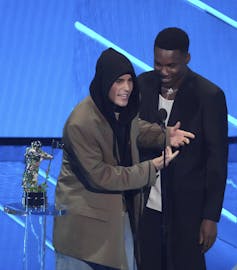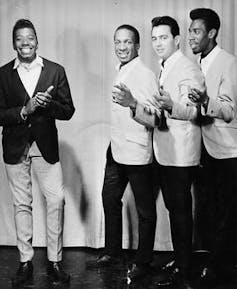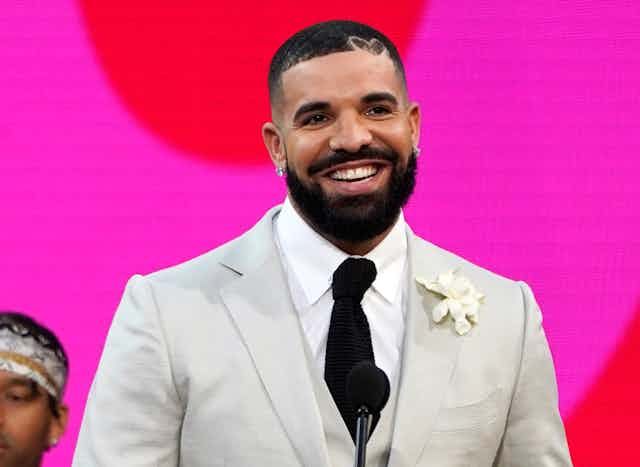Drake and Justin Bieber are among the biggest popular music stars in the world.
Part of their appeal has been blurring pop, hip-hop and R&B — music genres the music business has traditionally segregated along racialized lines.
My doctoral research has examined how Drake, Bieber and Jessie Reyez each innovatively approach R&B music — and build distinctly Canadian lifestyle brands that reinforce, complicate and/or challenge dominant beliefs about Canadian identities as exclusively white and R&B as a genre style exclusively practised by Black American artists.
‘Race records’
Associations between an artist’s skin colour and the classification of their music have long existed. Billboard music charts created the music genre chart “race records” in 1947 to exclusively group Black identities. This chart, in part, gave some visibility to Black artists who were largely marginalized in society. However, the category “race records” overgeneralized the diverse styles of music created by Black artists.
“Race record” artists were understood as “Black” and “old-time” artists were understood as “white southerners.” Billboard later renamed the “race record” chart “R&B,” then “Black singles” and then again back to “R&B.” In 1949, RCA Victor, a major record company in the United States, also used the term “blues and rhythm” for a cerise-coloured record featuring primarily Black artists.

Racialized categories continue today
Dominant archetypes of Black rappers and white country singers continue to shape expectations around genre.
In 2011, Black American artist Frank Ocean said: “… in America, it’s the first thing that comes to mind. If you’re a singer and you’re Black, you’re an R&B artist. Period.”
Journalist Elias Leight noted in 2019 that Black artist Lil Nas X’s song “Old Town Road” featuring Billy Ray Cyrus was removed from Billboard’s Hot Country Charts despite the clear country sounds in the song and music video. Instead, it was included in Billboard’s “Hot R&B/Hip-Hop Songs” chart.
Writer Teofilo Killip has noted:
“Country music” is “what some people classify as ‘white people music.’ But, like most stereotypes, that simply isn’t true … music really has no boundaries … [yet] there’s a bit of cognitive dissonance when you hear the words ‘Black country singer.’”
Canadian artist Shawn Desman, who is of Portuguese and Italian descent, has said people usually assumed he was Black because of his participation in R&B.
Canada’s R&B pioneers
Music journalist Larry LeBlanc, formerly Billboard’s Canadian bureau chief, noted in a 2006 interview that Toronto was “a strong R&B town” in the 50s, 60s and early 70s. Yet, “that scene remained separate from the Canadian recording industry,” which failed to support Canadian R&B artists.
Canadian R&B and hip-hop artists have long contributed to Canadian culture. But racism shaped representations of Canada as an exclusively white rock and country nation.
Black Canadian Eleanor Collins became known as “Canada’s first lady of jazz” in the 1950s, but she was not inducted into the Order of Canada until 2014.
Based on the racism they faced, a Canadian R&B group named their band by re-appropriating a racial slur used to describe Black people: “The Shades.”
As described by former Shades member (also comedian and actor) Tommy Chong, his fellow Shades members were Black and Indigenous (Sarcee/Tsuut’ina), while his ancestry is Chinese-Scottish-Irish, and together “they represented these different shades of skin colour.”

When the Shades got a Black American lead singer and renamed themselves Bobby Taylor and The Vancouvers, they landed on Billboard’s R&B music charts.
Unfortunately, like The Shades, another R&B band Crack of Dawn, who were the first Black Canadian group to land a major label deal, were also overlooked in much of Canadian music history that focuses on white rock and folk artists.
Whitewashed music histories
As hip hop scholars Mark Campbell and Charity Marsh write, “historically, [Canadian] archives have been manipulated to whitewash and straighten out histories and herstories.”
Their work chronicles how “there had been little interest in documenting [Canadian hip-hop] stories and cataloguing [Canadian] hip-hop artifacts in the past.”

This year, four-time Juno award winner Kardinal Offishall noted many amazing things have happened in Canada’s 50 years of hip-hop and “we need to do a better job in Canada commemorating the history, the people and their contributions.”
Racially diverse Canadian hip-hop and R&B artists have, in part, emerged from the peripheries by working together and blending the sounds of hip-hop and R&B with long-supported pop music styles.
Redefining ‘R&B’

Journalist Carl Wilson writes that the racial and Canadian national identities of The Weeknd and Drake complicates the “hip hop’s standard” which traditionally groups Black American identities exclusively in hip-hop.
Torontonian Drake rapped in his 2015 song “You & The 6” that he has been criticized for “not being Black enough” to participate in hip-hop and R&B music.
Drake has alluded to different cultures, locations and social identities through his music videos to articulate a hybrid identity as an “authentic” Black/Jewish, American/Canadian, working-class member of society — and a high-class rapper. The singer’s father is a Black American, while his mother is a white Jewish Canadian.

Beyond Drake, Bieber and Reyez also offer unique opportunities to analyze how framings of race and nationality play into people’s expectations of R&B.
White Canadian Bieber has challenged the Grammy Awards for classifying his music as pop and not R&B.
Second-generation Colombian Canadian woman Reyez won the JUNO Award for R&B/Soul Recording of the Year in 2019 and 2020.
In 2021, the Junos split the original R&B Recording of the Year award into two separate categories, Contemporary R&B/Soul Recording of the Year and Traditional R&B/Soul Recording of the Year.

Reyez was excluded from consideration for the Traditional R&B award, but won Contemporary R&B recording of the year in 2023.
The new Junos classification of R&B signifies a new kind of R&B that blends traditionally segregated styles of pop, R&B, rap and hip-hop — which Drake, Bieber and Reyez each represent today as unique, yet equally Canadian, R&B artists.

